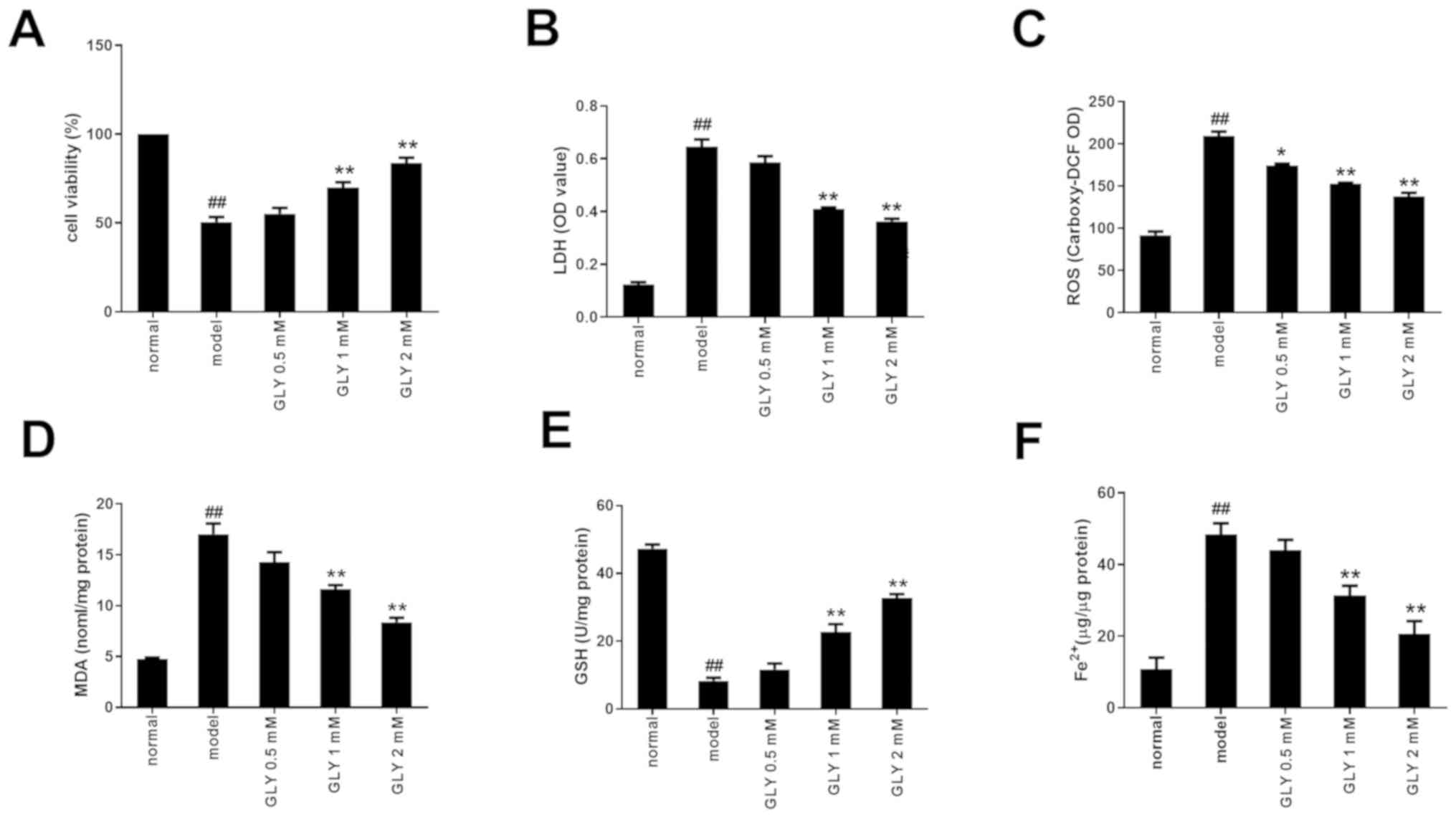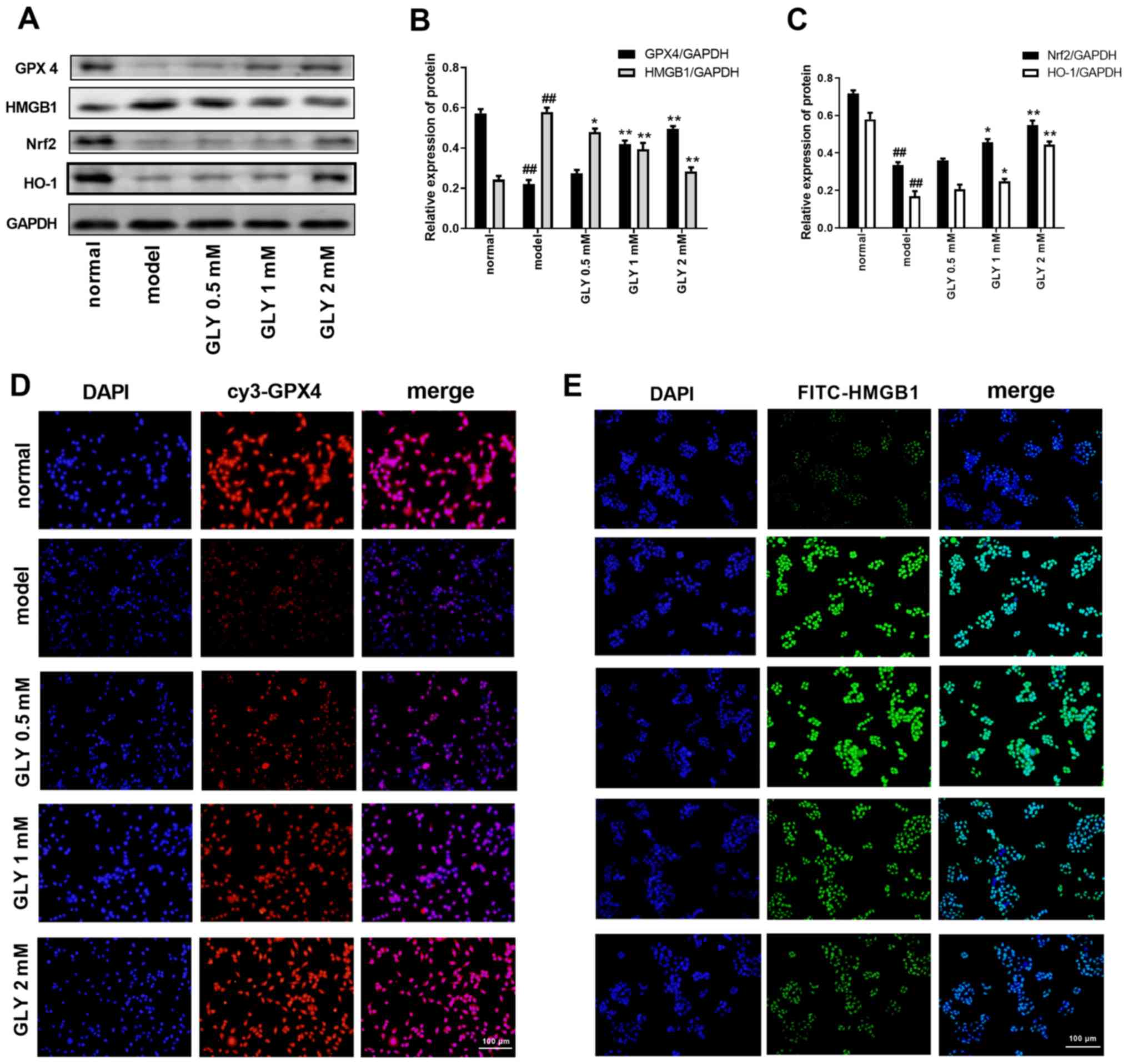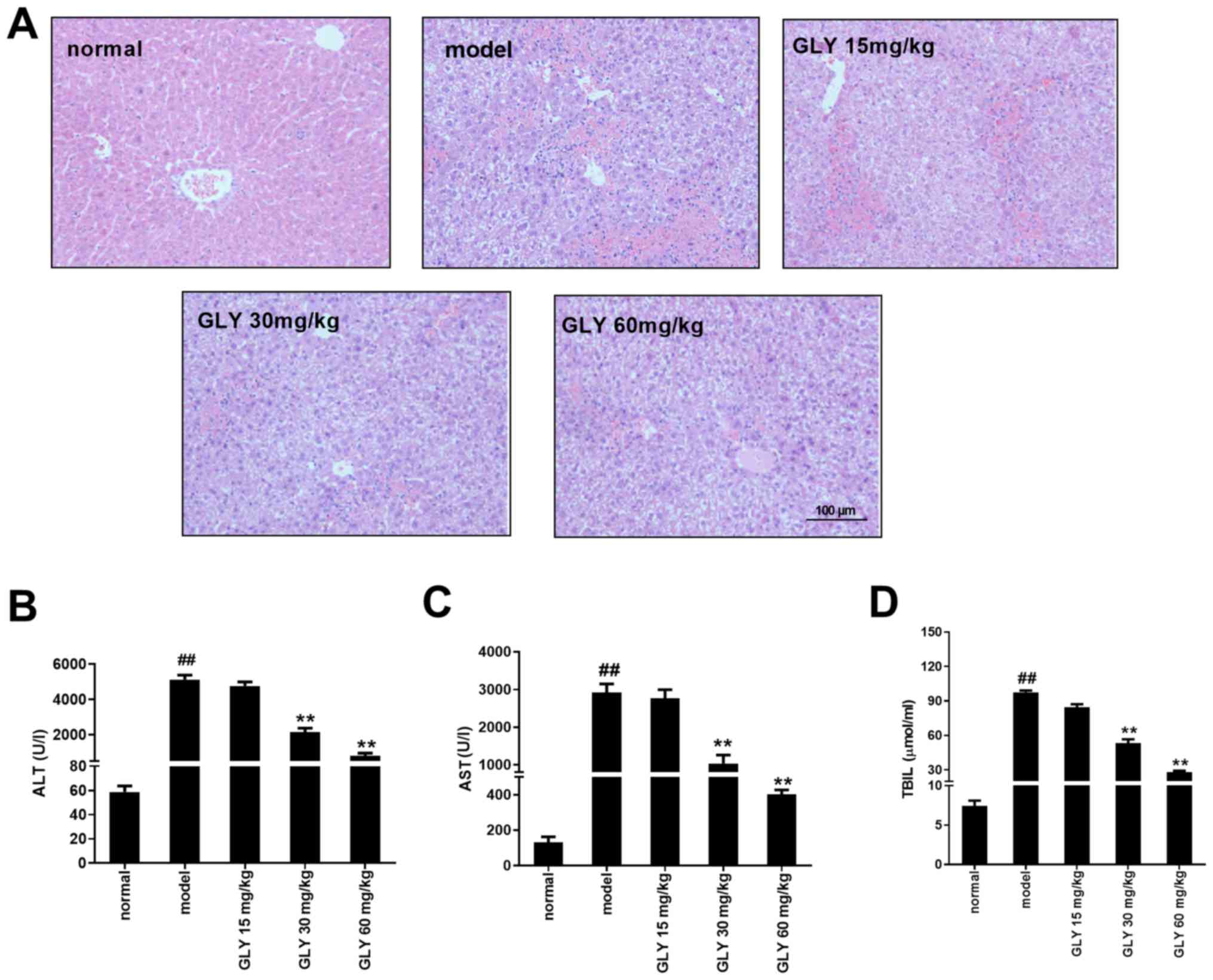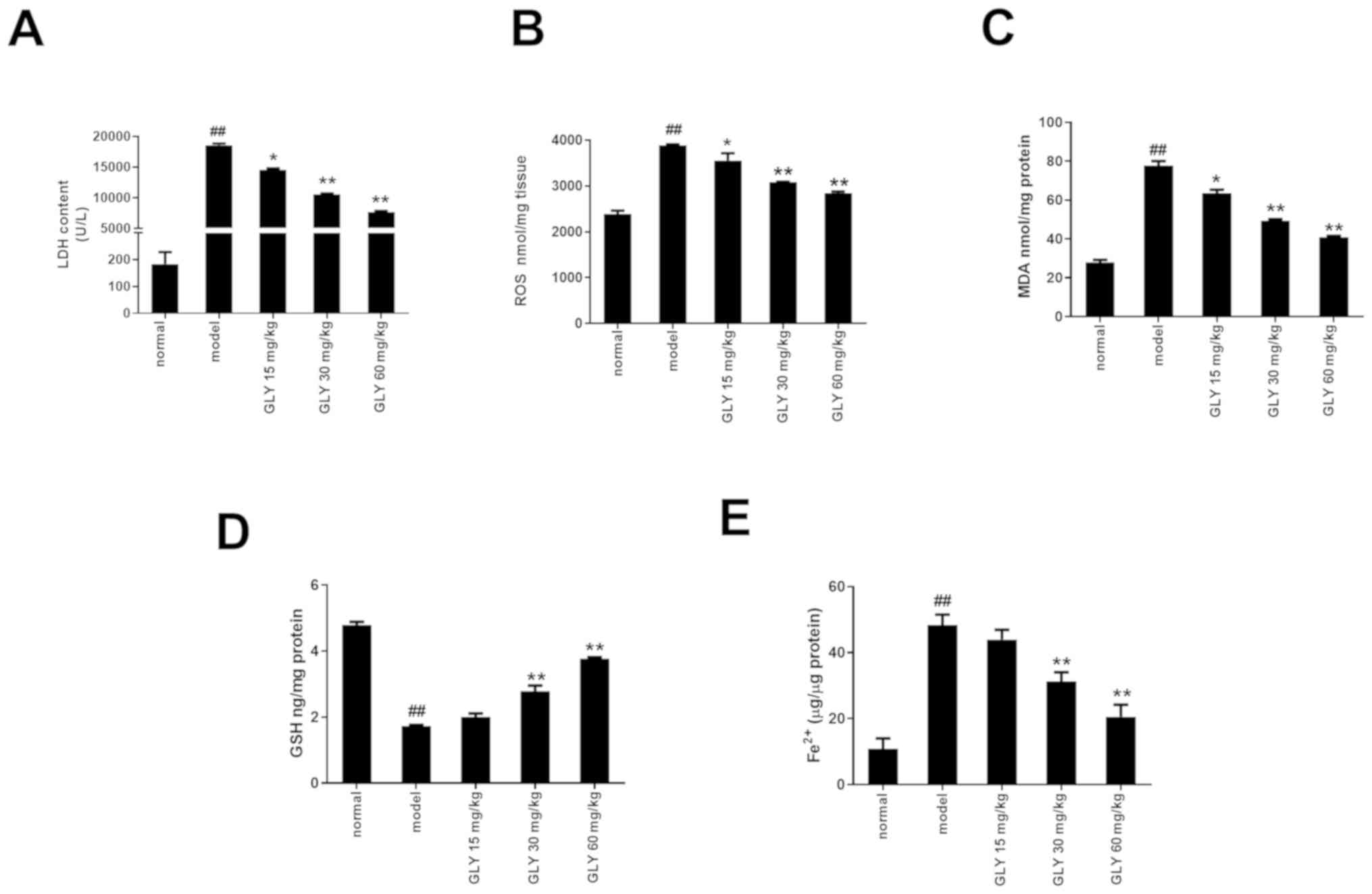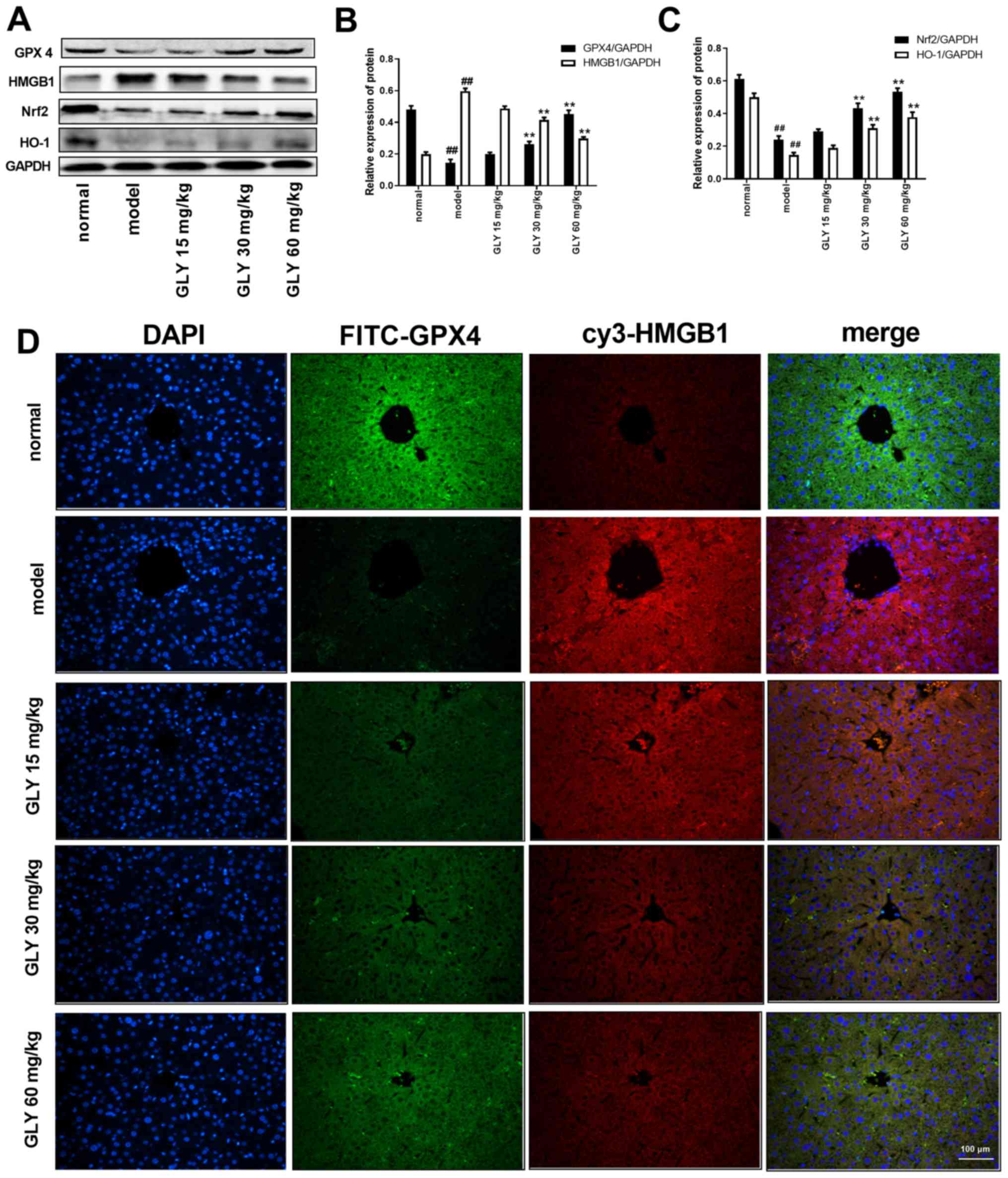|
1
|
Bernal W, Auzinger G, Dhawan A and Wendon
J: Acute liver failure. Lancet. 376:190–201. 2010. View Article : Google Scholar : PubMed/NCBI
|
|
2
|
Liu Y, Wang Y, Chen Q, Jiao F, Wang L and
Gong Z: HDAC2 inhibitor CAY10683 reduces intestinal epithelial cell
apoptosis by inhibiting mitochondrial apoptosis pathway in acute
liver failure. Histol Histopathol. 29:181202019.
|
|
3
|
Wang Y, Chen H, Chen Q, Jiao FZ, Zhang WB
and Gong ZJ: The protective mechanism of CAY10683 on intestinal
mucosal barrier in acute liver failure through LPS/TLR4/MyD88
pathway. Mediators Inflamm. 13:78596012018.
|
|
4
|
Dixon SJ, Lemberg KM, Lamprecht MR, Skouta
R, Zaitsev EM, Gleason CE, Patel DN, Bauer AJ, Cantley AM, Yang WS,
et al: Ferroptosis: An iron-dependent form of nonapoptotic cell
death. Cell. 149:1060–1072. 2012. View Article : Google Scholar : PubMed/NCBI
|
|
5
|
Wei L, Ren F, Zhang X, Wen T, Shi H, Zheng
S, Zhang J, Chen Y, Han Y and Duan Z: Oxidative stress promotes
D-GalN/LPS-induced acute hepatotoxicity by increasing glycogen
synthase kinase 3β activity. Inflamm Res. 63:485–494. 2014.
View Article : Google Scholar : PubMed/NCBI
|
|
6
|
Mishra D, Jain N, Rajoriya V and Jain AK:
Glycyrrhizin conjugated chitosan nanoparticles for
hepatocyte-targeted delivery of lamivudine. J Pharm Pharmacol.
66:1082–1093. 2014.PubMed/NCBI
|
|
7
|
Nazari S, Rameshrad M and Hosseinzadeh H:
Toxicological effects of glycyrrhiza glabra (Licorice): A review.
Phytother Res. 31:1635–1650. 2017. View
Article : Google Scholar : PubMed/NCBI
|
|
8
|
Michaelis M, Geiler J, Naczk P, Sithisarn
P, Leutz A, Doerr HW and Cinatl J Jr: Glycyrrhizin exerts
antioxidative effects in H5N1 influenza A virus-infected cells and
inhibits virus replication and pro-inflammatory gene expression.
PLoS One. 6:e197052011. View Article : Google Scholar : PubMed/NCBI
|
|
9
|
Ojha S, Javed H, Azimullah S, Abul Khair
SB and Haque ME: Glycyrrhizic acid attenuates neuroinflammation and
oxidative stress in rotenone model of parkinson's disease. Neurotox
Res. 29:275–287. 2016. View Article : Google Scholar : PubMed/NCBI
|
|
10
|
Wang XR, Hao HG and Chu L: Glycyrrhizin
inhibits LPS-induced inflammatory mediator production in
endometrial epithelial cells. Microb Pathog. 109:110–113. 2017.
View Article : Google Scholar : PubMed/NCBI
|
|
11
|
Zhou Y, Tong X, Ren S, Wang X, Chen J, Mu
Y, Sun M, Chen G, Zhang H and Liu P: Synergistic anti-liver
fibrosis actions of total astragalus saponins and glycyrrhizic acid
via TGF-β1/Smads signaling pathway modulation. J Ethnopharmacol.
190:83–90. 2016. View Article : Google Scholar : PubMed/NCBI
|
|
12
|
Lin CC and Wang PH: Intravenous
glycyrrhizin improved serum transaminases rapidly in a chronic
hepatitis B patient with acute exacerbation. J Formosan Med Assoc.
114:188–189. 2015. View Article : Google Scholar : PubMed/NCBI
|
|
13
|
Kong ZH, Chen X, Hua HP, Liang L and Liu
LJ: The oral pretreatment of glycyrrhizin prevents surgery-induced
cognitive impairment in aged mice by reducing neuroinflammation and
alzheimer's-related pathology via HMGB1 inhibition. J Mol Neurosci.
63:385–395. 2017. View Article : Google Scholar : PubMed/NCBI
|
|
14
|
Mittler R, Vanderauwera S, Suzuki N,
Miller G, Tognetti VB, Vandepoele K, Gollery M, Shulaev V and Van
Breusegem F: ROS signaling: The new wave? Trends Plant Sci.
16:300–309. 2011. View Article : Google Scholar : PubMed/NCBI
|
|
15
|
Xie Y, Hou W, Song X, Yu Y, Huang J, Sun
X, Kang R and Tang D: Ferroptosis: Process and function. Cell Death
Differ. 23:369–379. 2016. View Article : Google Scholar : PubMed/NCBI
|
|
16
|
Barrera G, Pizzimenti S, Daga M, Dianzani
C, Arcaro A, Cetrangolo GP, Giordano G, Cucci MA, Graf M and
Gentile F: Lipid peroxidation-derived aldehydes, 4-hydroxynonenal
and malondialdehyde in aging-related disorders. Antioxidants
(Basel). 30:82018.
|
|
17
|
Levine WG: Glutathione and hepatic
mixed-function oxidase activity. Drug Metab Rev. 14:909–930. 1983.
View Article : Google Scholar : PubMed/NCBI
|
|
18
|
Du J, Wang T, Li Y, Zhou Y, Wang X, Yu X,
Ren X, An Y, Wu Y, Sun W, et al: DHA inhibits proliferation and
induces ferroptosis of leukemia cells through autophagy dependent
degradation of ferritin. Free Radic Biol Med. 131:356–369. 2019.
View Article : Google Scholar : PubMed/NCBI
|
|
19
|
Proneth B and Conrad M: Ferroptosis and
necroinflammation, a yet poorly explored link. Cell Death Differ.
26:14–24. 2019. View Article : Google Scholar : PubMed/NCBI
|
|
20
|
Latunde-Dada GO: Ferroptosis: Role of
lipid peroxidation, iron and ferritinophagy. Biochimica Biophysica
Acta Gen Subj. 1861:1893–1900. 2017. View Article : Google Scholar
|
|
21
|
Hamesch K, Borkham-Kamphorst E, Strnad P
and Weiskirchen R: Lipopolysaccharide-induced inflammatory liver
injury in mice. Lab Anim. 49:37–46. 2015. View Article : Google Scholar : PubMed/NCBI
|
|
22
|
Maes M, Vinken M and Jaeschke H:
Experimental models of hepatotoxicity related to acute liver
failure. Toxicol Appl Pharmacol. 290:86–97. 2016. View Article : Google Scholar : PubMed/NCBI
|
|
23
|
Zhuo T, Zhou S, Zhang W, Lambertucci C and
Volpini R: Synthesis and ability of new ligands for G
protein-coupled receptors 17 (GPR17). Med Sci Monit. 23:953–959.
2017. View Article : Google Scholar : PubMed/NCBI
|
|
24
|
Song J, Lu C, Zhao W and Shao X: Melatonin
attenuates TNF-α-mediated hepatocytes damage via inhibiting
mitochondrial stress and activating the Akt-Sirt3 signaling
pathway. J Cell Physiol. 234:20969–20979. 2019. View Article : Google Scholar : PubMed/NCBI
|
|
25
|
Shang Y, Liu Y, Du L, Wang Y, Cheng X,
Xiao W, Wang X, Jin H, Yang X, Liu S and Chen Q: Targeted
expression of uncoupling protein 2 to mouse liver increases the
susceptibility to lipopolysaccharide/galactosamine-induced acute
liver injury. Hepatology. 50:1204–1216. 2009. View Article : Google Scholar : PubMed/NCBI
|
|
26
|
Chai FN, Zhang J, Xiang HM, Xu HS, Li YF,
Ma WY, Li XG and Ye XL: Protective effect of coptisine from rhizoma
coptidis on LPS/D-GalN-induced acute liver failure in mice through
up-regulating expression of miR-122. Biomed Pharmacother.
98:180–190. 2018. View Article : Google Scholar : PubMed/NCBI
|
|
27
|
Yan X, Jiang Z, Bi L, Yang Y and Chen W:
Salvianolic acid A attenuates TNF-α- and D-GalN-induced ER
stress-mediated and mitochondrial-dependent apoptosis by modulating
Bax/Bcl-2 ratio and calcium release in hepatocyte LO2 cells. Naunyn
Schmiedebergs. Arch Pharmacol. 388:817–830. 2015. View Article : Google Scholar
|
|
28
|
Yu H, Guo P, Xie X, Wang Y and Chen G:
Ferroptosis, a new form of cell death, and its relationships with
tumourous diseases. J Cell Mol Med. 21:648–657. 2017. View Article : Google Scholar : PubMed/NCBI
|
|
29
|
Yoshida M, Minagawa S, Araya J, Sakamoto
T, Hara H, Tsubouchi K, Hosaka Y, Ichikawa A, Saito N, Kadota T, et
al: Involvement of cigarette smoke-induced epithelial cell
ferroptosis in COPD pathogenesis. Nat Commun. 10:31452019.
View Article : Google Scholar : PubMed/NCBI
|
|
30
|
Anderson GJ and Frazer DM: Current
understanding of iron homeostasis. Am J Clin Nutr. 106 (Suppl
6):1559S–1566S. 2017. View Article : Google Scholar : PubMed/NCBI
|
|
31
|
Gauss GH, Kleven MD, Sendamarai AK,
Fleming MD and Lawrence CM: The crystal structure of
six-transmembrane epithelial antigen of the prostate 4 (Steap4), a
ferri/cuprireductase, suggests a novel interdomain flavin-binding
site. J Biol Chem. 288:20668–20682. 2013. View Article : Google Scholar : PubMed/NCBI
|
|
32
|
Chen D, Eyupoglu IY and Savaskan N:
Ferroptosis and cell death analysis by flow cytometry. Methods Mol
Biol. 1601:71–77. 2017. View Article : Google Scholar : PubMed/NCBI
|
|
33
|
Sun X, Ou Z, Chen R, Niu X, Chen D, Kang R
and Tang D: Activation of the p62-Keap1-NRF2 pathway protects
against ferroptosis in hepatocellular carcinoma cells. Hepatology.
63:173–184. 2016. View Article : Google Scholar : PubMed/NCBI
|
|
34
|
Hu J, Kholmukhamedov A, Lindsey CC, Beeson
CC, Jaeschke H and Lemasters JJ: Translocation of iron from
lysosomes to mitochondria during acetaminophen-induced
hepatocellular injury: Protection by starch-desferal and
minocycline. Free Radic Biol Med. 97:418–426. 2016. View Article : Google Scholar : PubMed/NCBI
|
|
35
|
Carlson BA, Tobe R, Yefremova E, Tsuji PA,
Hoffmann VJ, Schweizer U, Gladyshev VN, Hatfield DL and Conrad M:
Glutathione peroxidase 4 and vitamin E cooperatively prevent
hepatocellular degeneration. Redox Biol. 9:22–31. 2016. View Article : Google Scholar : PubMed/NCBI
|
|
36
|
Ritchie RH, Drummond GR, Sobey CG, De
Silva TM and Kemp-Harper BK: The opposing roles of NO and oxidative
stress in cardiovascular disease. Pharmacol Res. 116:57–69. 2017.
View Article : Google Scholar : PubMed/NCBI
|
|
37
|
Niemann B, Rohrbach S, Miller MR, Newby
DE, Fuster V and Kovacic JC: Oxidative stress and cardiovascular
risk: Obesity, diabetes, smoking, and pollution part 3 of a 3-part
series. J Am Coll Cardiol. 70:230–251. 2017. View Article : Google Scholar : PubMed/NCBI
|
|
38
|
Henchcliffe C and Beal MF: Mitochondrial
biology and oxidative stress in parkinson disease pathogenesis.
Nature Clin Pract Neurol. 4:600–609. 2008. View Article : Google Scholar
|
|
39
|
Maiorino M, Conrad M and Ursini F: GPx4,
Lipid peroxidation, and cell death: Discoveries, rediscoveries, and
open issues. Antioxid Redox Signal. 29:61–74. 2018. View Article : Google Scholar : PubMed/NCBI
|
|
40
|
Ma Q: Role of nrf2 in oxidative stress and
toxicity. Annu Rev Pharmacol Toxicol. 53:401–426. 2013. View Article : Google Scholar : PubMed/NCBI
|
|
41
|
Chang CY, Kao TK, Chen WY, Ou YC, Li JR,
Liao SL, Raung SL and Chen CJ: Tetramethylpyrazine inhibits
neutrophil activation following permanent cerebral ischemia in
rats. Biochem Biophys Res Commun. 463:421–427. 2015. View Article : Google Scholar : PubMed/NCBI
|
|
42
|
Kim SR, Ha YM, Kim YM, Park SW, Kim HJ,
Chung HT and Chang KC: Ascorbic acid reduces HMGB1 secretion in
lipopolysaccharide-activated RAW 264.7 cells and improves survival
rate in septic mice by activation of Nrf2/HO-1 signals. Biochem
Pharmacol. 95:279–289. 2015. View Article : Google Scholar : PubMed/NCBI
|
|
43
|
Liu C, Zhu C, Wang G, Xu R and Zhu Y:
Higenamine regulates Nrf2-HO-1-Hmgb1 axis and attenuates intestinal
ischemia-reperfusion injury in mice. Inflammation Res. 64:395–403.
2015. View Article : Google Scholar
|
|
44
|
Andersson U and Tracey KJ: HMGB1 is a
therapeutic target for sterile inflammation and infection. Ann Rev
Immunol. 29:139–162. 2011. View Article : Google Scholar
|
|
45
|
Yu M, Wang HC, Ding AH, Golenbock DT, Latz
E, Czura CJ, Fenton MJ, Tracey KJ and Yang H: HMGB1 signals through
toll-like receptor (TLR) 4 and TLR2. Shock. 26:174–179. 2006.
View Article : Google Scholar : PubMed/NCBI
|
|
46
|
Yang RK, Zou XP, Tenhunen J and Tonnessen
TI: HMGB1 and extracellular histones significantly contribute to
systemic inflammation and multiple organ failure in acute liver
failure. Mediators Inflamm. 2017:59280782017. View Article : Google Scholar : PubMed/NCBI
|
|
47
|
Lv YH, Li YL, Zhang DD, Zhang AB, Guo WH
and Zhu SF: HMGB1-induced asthmatic airway inflammation through
GRP75-mediated enhancement of ER-mitochondrial Ca2+
transfer and ROS increased. J Cell Biochem. 119:4205–4215. 2018.
View Article : Google Scholar : PubMed/NCBI
|
|
48
|
Carreno V: Review article: Management of
chronic hepatitis C in patients with contraindications to
anti-viral therapy. Aliment Pharmacol Ther. 39:148–162. 2014.
View Article : Google Scholar : PubMed/NCBI
|
|
49
|
Milosevic N, Milanovic M, Turkulov V,
Medic-Stojanoska M, Abenavoli L and Milic N: May patients with
alcohol liver disease benefit from herbal medicines? Rev Recent
Clin Trials. 11:227–237. 2016. View Article : Google Scholar : PubMed/NCBI
|
|
50
|
Sun X, Duan X, Wang C, Liu Z, Sun P, Huo
X, Ma X, Sun H, Liu K and Meng Q: Protective effects of
glycyrrhizic acid against non-alcoholic fatty liver disease in
mice. Eur J Pharmacol. 806:75–82. 2017. View Article : Google Scholar : PubMed/NCBI
|
|
51
|
Wang H, Fang ZZ, Meng R, Cao YF, Tanaka N,
Krausz KW and Gonzalez FJ: Glycyrrhizin and glycyrrhetinic acid
inhibits alpha-naphthyl isothiocyanate-induced liver injury and
bile acid cycle disruption. Toxicology. 386:133–142. 2017.
View Article : Google Scholar : PubMed/NCBI
|
|
52
|
Sil R, Ray D and Chakraborti AS:
Glycyrrhizin ameliorates metabolic syndrome-induced liver damage in
experimental rat model. Mol Cell Biochem. 409:177–189. 2015.
View Article : Google Scholar : PubMed/NCBI
|
|
53
|
Yan T, Wang H, Zhao M, Yagai T, Chai Y,
Krausz KW, Xie C, Cheng X, Zhang J, Che Y, et al: Glycyrrhizin
protects against acetaminophen-induced acute liver injury via
alleviating tumor necrosis factor α-mediated apoptosis. Drug Metab
Dispos. 44:720–731. 2016. View Article : Google Scholar : PubMed/NCBI
|
|
54
|
Zhang X, Yang H, Yue S, He G, Qu S, Zhang
Z, Ma B, Ding R, Peng W, Zhang H, et al: The mTOR inhibition in
concurrence with ERK1/2 activation is involved in excessive
autophagy induced by glycyrrhizin in hepatocellular carcinoma.
Cancer Med. 6:1941–1951. 2017. View Article : Google Scholar : PubMed/NCBI
|
|
55
|
Mollica L, De Marchis F, Spitaleri A,
Dallacosta C, Pennacchini D, Zamai M, Agresti A, Trisciuoglio L,
Musco G and Bianchi ME: Glycyrrhizin binds to high-mobility group
box 1 protein and inhibits its cytokine activities. Chem Biol.
14:431–441. 2007. View Article : Google Scholar : PubMed/NCBI
|
|
56
|
Li YJ, Wang L, Zhang B, Gao F and Yang CM:
Glycyrrhizin, an HMGB1 inhibitor, exhibits neuroprotective effects
in rats after lithium-pilocarpine-induced status epilepticus. J
Pharm Pharmacol. 71:390–399. 2019. View Article : Google Scholar : PubMed/NCBI
|
|
57
|
Wang LW, Chen H and Gong ZJ: High mobility
group box-1 protein inhibits regulatory T cell immune activity in
liver failure in patients with chronic hepatitis B. Hepatobiliary
Pancreat Dis Int. 9:499–507. 2010.PubMed/NCBI
|
|
58
|
Abo El-Magd NF, El-Mesery M, El-Karef A
and El-Shishtawy MM: Glycyrrhizin ameliorates high fat diet-induced
obesity in rats by activating NrF2 pathway. Life Sci. 193:159–170.
2018. View Article : Google Scholar : PubMed/NCBI
|















